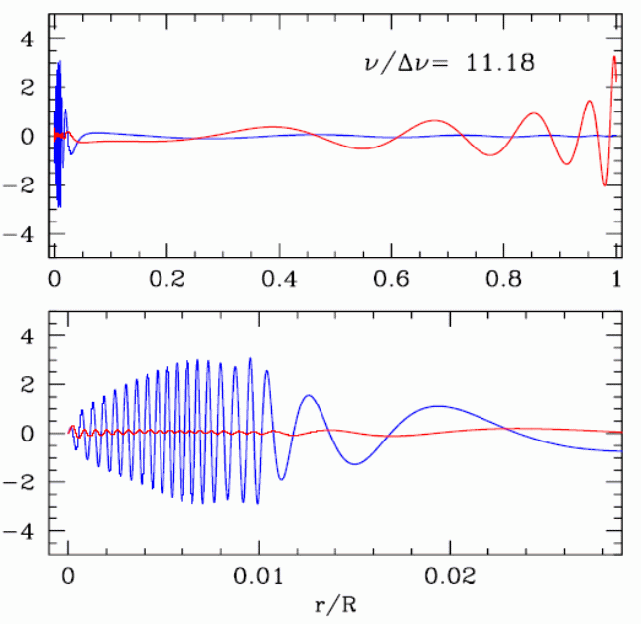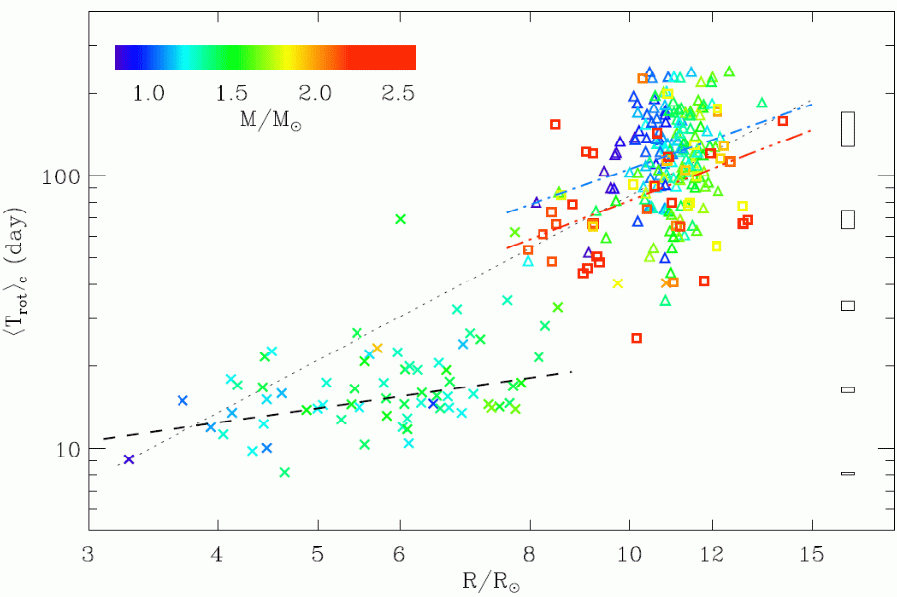One of the great achievements of the CNES-led mission CoRoT is undoubtedly the observation of solar-like oscillations in red giants (De Ridder et al. 2009, Nature 459, 398). As in the Sun, they are excited by turbulent convection in the outer layers ; in the stellar envelope, these oscillations correspond to pressure waves. Contrary to the Sun, their oscillation spectrum is much more complex. Red giants have a pure helium core that defines a cavity clearly different from the envelope where gravity waves can propagate. For dipole modes, conditions are met to ensure the efficient coupling of pressure and gravity waves. This coupling gives raise to mixed modes with non-negligible amplitudes both at the stellar surface and in the core. These mixed modes are therefore clearly observable and unveil phenomena occurring in the core (Fig. 1).

Click on the image to enlarge it
With Kepler observations, an international team driven by the group Etoile (=star) of the LESIA has put in evidence the spinning down of the core of red giants. The monitoring of hundreds of red giants at different evolutionary stages has shown that the period of the core rotation increases when the star ascends the red giant branch, despite the fact that the core contracts (Fig. 2). Without redistribution of angular momentum inside the star, the core rotation should speed up. But seismic measurements prove that the cores rotate slowly. These measurements are derived from the rotational splittings of the mixed modes (Fig. 3). Measuring these splittings is possible only if one can measure the unperturbed mixed modes. This is a recent skill developed at LESIA too. The phenomenological approach for identifying the splittings has also been validated on a theoretical basis by the team.

Click on the image to enlarge it
The spinning down governed by the global expansion of a star on the red giant branch indicates that internal angular momentum is redistributed between the different regions, in order to lower the rotation gradients. This spinning down, suspected but never directly observed, can now be precisely measured and modeled.
The new theoretical tools for interpreting the seismic observations prove that mixed modes primilarly unveil the core rotation but can also give access to the rotation of the envelope. This rotation is so slow that its measurement is extremely challenging and will highly benefit from the extent of the Kepler mission till 2016.

Cliquer sur l’image pour l’agrandir
Références
- Marques, J.P., et al 2012, Seismic diagnostics for transport of angular momentum in stars 1. Rotational splittings from the PMS to the RGB Astron. Astrophys. in press
- Goupil M. J. et al. 2013, Seismic diagnostics for transport of angular momentum in stars 2. Interpreting observed rotational splittings of slowly-rotating red giant stars. Astron. Astrophys. in press
- Mosser B. et al. 2012, Spin down of the core rotation in red giants. Astron. Astrophys. in press
Previous news related to this subject
- To see the heart of stars rotate
- Stellar mass loss : the recipe from giant stars
- The age of red giants uncovered by Kepler and CoRoT
- The red-giant oscillation universal pattern
Contact
- Benoit Mosser (Observatoire de Paris-LESIA, CNRS)

